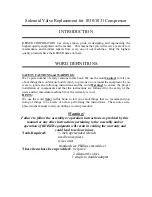
D–EIMWC00808-16HU - 56/64
Oil Analysis
Interpreting Oil Analysis Data
Oil wear metals analysis has long been recognized as a useful tool for indicating the internal condition of rotating
machinery and continues to be a preferred method for Daikin centrifugal chillers. Daikin Service or a number of
laboratories specializing in oil testing can do the test. To accurately estimate the internal condition it is essential to
properly interpret the oil wear test results.
Numerous test results from various testing laboratories have recommended action that has prompted unnecessary
concern by customers. Polyolester oils are excellent solvents and can readily dissolve trace elements and
contaminants. Most of these elements and contaminates eventually end up in the oil. Also, the polyolester oils used
in R-134a chillers are more hygroscopic than mineral oils and can contain much more water in solution. For this
reason, it is imperative that extra care be used when handling polyolester oils to minimize their exposure to ambient
air. Extra care must also be used when sampling to ensure that sample containers are clean, moisture-free leak proof
and non-permeable.
Daikin has done extensive testing in conjunction with refrigerant and lubricating oil manufacturers and has
established guidelines to determine action levels and the type of action required. Table 1 indicates these parameters.
In general Daikin does not recommend changing lubricating oils and filters on a periodic basis. The need to change
lubricating oil and filters should be based on a careful consideration of oil analysis, vibration analysis and knowledge
of the operating history of the equipment. A single oil sample is not sufficient to estimate the condition of the chiller.
Oil analysis is only useful if employed to establish wear trends over time. Changing lubricating oil and filter prior
to when its needed will reduce the effectiveness of oil analysis as a tool in determining machinery condition.
The following metallic elements or contaminates and their possible sources will typically be identified in an oil wear
analysis.
Aluminum
Typical sources of aluminum are bearings, impellers, seals or casting material. An increase in
aluminum content in the lubricating oil may be an indication of bearing, impeller or other wear.
A corresponding increase in other wear metals may also accompany an increase in aluminum
content.
Copper
The source of copper can be the evaporator or condenser tubes, copper tubing used in the
lubrication and motor cooling systems or residual copper from the manufacturing process. The
presence of copper may be accompanied by a high TAN (total acid number) and high moisture
content. High copper contents may also result from residual mineral oil in machines which have
been converted to R-134a. Some mineral oils contained wear inhibitors which react with copper
and result in high copper content in lubricating oil.
Iron
Iron in the lubricating oil can originate from compressor castings, oil pump components, shells,
tube sheets, tube supports, shaft material and rolling element bearings. High iron content may
also result from residual mineral oil in machines which have been converted to R-134a. Some
mineral oils contain wear inhibitors which react with iron and can result in a high iron content in
the lubricating oil.
Tin
The source of tin may be from bearings.
Zinc
There is no zinc used in the bearings on Daikin chillers. The source, if any may be from
additives in some mineral oils.













































